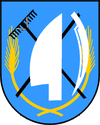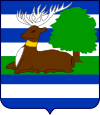Tovarnik
| Tovarnik | ||
|---|---|---|
| Municipality | ||
|
| ||
| ||
 Tovarnik Location in Croatia | ||
| Coordinates: 45°10′N 19°9′E / 45.167°N 19.150°ECoordinates: 45°10′N 19°9′E / 45.167°N 19.150°E | ||
| Country |
| |
| County |
| |
| Population (2011) | ||
| • Total | 2,775 | |
| Time zone | CET (UTC+1) | |
| • Summer (DST) | CEST (UTC+2) | |
| Postal code | 32249 | |
| Area code(s) | 32 | |
| Vehicle registration | VU | |
Tovarnik (pronounced [tǒvaːrniːk]) is a municipality in the Vukovar-Syrmia County in Croatia next to the border with Serbia. According to the 2001 census, there are 2,775 inhabitants, 91.06% which are Croats.[1] The municipality is part of Syrmia. It is the birthplace of great Croatian poet Antun Gustav Matoš.

Geography
The municipality is located in historical regions of Syrmia. The total area of the municipality is 64.56 km2. The territory of the municipality is completely flat with very fertile black soil.
Climate and weather
Tovarnik municipality has a moderately warm and rainy continental climate as defined by the Köppen climate classification. Due to the influence of continentality temperature differences within one year are more pronounced than in the rest of country.
European migrant crisis
Since the city of Tovarnik is next to the border with Serbia and nearly 80% of the border consist of the Danube river, but there is a 70 kilometers-long so-called "Green Border" near Tovarnik and is therefore at risk for a strong inflow of migrants from Serbia considering that Hungary erected a fence on its border with Serbia. Also, parts of the Croatia-Serbia border are known minefields, which represent a considerable threat. According to the Croatian Minister of Interior Ranko Ostojić, "police in the area have enough people and equipment to protect the Croatian border against illegal immigrants".[2] Croatian President Kolinda Grabar-Kitarović and First Deputy Prime Minister Vesna Pusić have so far rejected the option of building a fence along the Croatian border with Serbia.[3][4] Croatian Prime Minister Zoran Milanović said his country is ready to help refugees coming to Europe, insisting that people fleeing conflict should be given the right to remain in the EU.[5]
On 15 September 2015, Croatia started to experience the first major waves of refugees of the Syrian Civil War. First Syrian refugees cross Croatia-Serbia border, carving out potential new route through Europe after Hungary seals borders.[6] On September 15, 2015, Hungary announced it would start arresting people crossing the border illegally, and as of early 16 September, Hungary had detained 519 people and pressed criminal charges against 46 for trespassing.[7] Thousands of migrants were subsequently led to pursue alternative routes through Croatia from Serbia.[7] After Hungary closed its border with Serbia on September 15, migrants headed towards the Serbian town of Šid, less than 10 kilometers from the Croatian border. Several buses filled with migrants arrived on the Croatian border crossing of Tovarnik, where the Croatian Vukovar-Srijem County Care and Rescue teams as well as the Croatian Red Cross were on standby awaiting migrants.[8] On September 17 at 3:30 AM, more than 5,000 migrants have arrived in Tovarnik.[9] Since the number of refugees is rising and expected to peak at 20,000, it is likely that they will be moved to Zagreb Fair as planned.[10] Interior Minister Ranko Ostojić said Croatia is "absolutely full" by the evening of 17 September 2015, and Croatia decided to close its border with Serbia.[11]
Gallery
Notable natives and residents
Settlements
The settlements of Ilača and Tovarnik comprise the Tovarnik municipality.
See also
References
- ↑ "Population by Ethnicity, by Towns/Municipalities, 2011 Census: County of Vukovar-Sirmium". Census of Population, Households and Dwellings 2011. Zagreb: Croatian Bureau of Statistics. December 2012.
- ↑ "Hrvatska na udaru imigranata, krizne točke Bajakovo i Tovarnik". Večernji.hr.
- ↑ T.V. "Grabar KitaroviĆ: Hrvatska neće graditi zidove prema Srbiji kao Mađarska". Dnevnik.hr.
- ↑ "'HRVATSKA NEĆE GRADITI ZIDOVE AKO VAL IZBJEGLICA KRENE PREMA NAMA' Vesna Pusić iskazala prezir prema mađarskom rješenju – Jutarnji.hr". jutarnji.hr.
- ↑ Croatian PM Pledges Help for Refugees
- ↑ Refugees cross Croatia border in search of new route
- 1 2 Rick Lyman and Dan Bilefsky (September 16, 2015). "Migrants Clash With Police in Hungary, as Others Enter Croatia". The New York Times. Retrieved September 16, 2015.
- ↑ http://www.index.hr/vijesti/clanak/pogledajte-video-i-fotografije-iz-tovarnika/842208.aspx
- ↑ http://www.jutarnji.hr/foto--izbjeglicka-drama-u-hr-u-hrvatsku-uslo-5650-izbjeglica--u-tovarniku-situacija-izmakla-kontroli/1419579/
- ↑ http://www.jutarnji.hr/izbjeglice-ce-biti-smjestene-na-velesajmu-satori-nicu-u-dva-paviljona--ali-nedostaje-plahti--deka--jastuka---/1419731/
- ↑ Migrant crisis: Croatian PM says country cannot stop migrants


